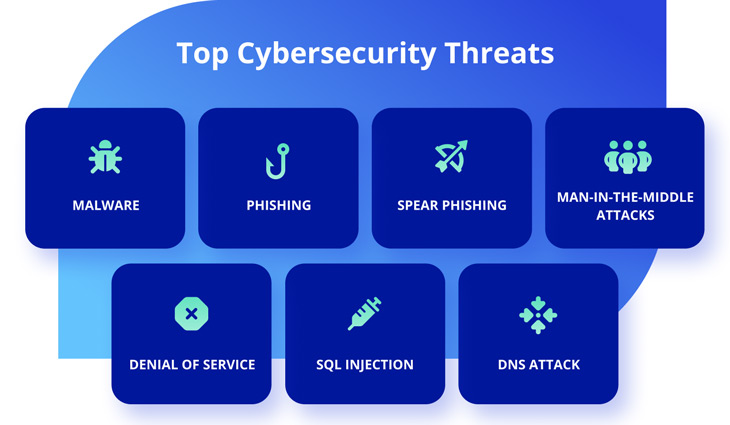

Cybersecurity Threats: The Growing Menace and How to Protect Yourself
In today’s digital age, the internet has become an integral part of our daily lives. We rely on it to communicate, access information, and perform various tasks. However, with the growth of the internet, cybersecurity threats have also increased exponentially. Cybercriminals are constantly finding new ways to exploit vulnerabilities and compromise sensitive information. It is essential to understand the different types of cybersecurity threats and take necessary measures to protect yourself from falling prey to these attacks.
Types of Cybersecurity Threats
- Malware: Malware is a type of malicious software that is designed to harm or exploit a computer system. It can take the form of viruses, worms, trojans, spyware, adware, and ransomware. Malware can spread through email attachments, infected software downloads, or infected websites.
- Phishing: Phishing is a type of social engineering attack where cybercriminals attempt to trick victims into revealing sensitive information such as login credentials, credit card numbers, or personal data. Phishing attacks often take the form of fake emails, texts, or messages that appear to be from a legitimate source.
- Ransomware: Ransomware is a type of malware that encrypts a victim’s files and demands payment in exchange for the decryption key. Ransomware attacks have become increasingly common in recent years, with many organizations and individuals falling victim to these attacks.
- SQL Injection: SQL injection is a type of attack where cybercriminals inject malicious code into a website’s database to access sensitive information. This type of attack is often used to steal sensitive data such as credit card numbers or personal information.
- Denial of Service (DoS) and Distributed Denial of Service (DDoS) Attacks: DoS and DDoS attacks are types of attacks where cybercriminals flood a website or network with traffic in an attempt to overwhelm it and make it inaccessible to users.
How to Protect Yourself from Cybersecurity Threats
While cybersecurity threats are a growing concern, there are several measures you can take to protect yourself from falling prey to these attacks.
- Use Strong Passwords: Using strong and unique passwords is essential to preventing unauthorized access to your accounts. Avoid using easily guessable passwords such as your name, birthdate, or common words. Instead, use a combination of uppercase and lowercase letters, numbers, and special characters.
- Enable Two-Factor Authentication: Two-factor authentication adds an extra layer of security to your accounts by requiring you to enter a verification code sent to your phone or email in addition to your password.
- Keep Your Software Up-to-Date: Keeping your operating system, browser, and other software up-to-date is essential to patching security vulnerabilities and preventing exploitation by cybercriminals.
- Use Antivirus Software: Installing antivirus software can help detect and prevent malware infections on your computer.
- Be Cautious of Phishing Attacks: Be cautious of suspicious emails, texts, or messages that ask for sensitive information. Verify the authenticity of the sender and avoid clicking on suspicious links or attachments.
- Use a Firewall: A firewall can help block unauthorized access to your computer or network by filtering incoming and outgoing traffic based on predetermined security rules.
- Use Encryption: Encrypting your data can help protect it from unauthorized access. Use encryption when sending sensitive information over the internet or storing it on your computer.
- Back up Your Data: Regularly backing up your data can help minimize the impact of a ransomware attack or other types of data loss.
- Use a VPN: A Virtual Private Network (VPN) can help protect your data when using public Wi-Fi networks by encrypting your internet traffic.
- Stay Informed: Stay informed about the latest cybersecurity threats and updates to stay ahead of cybercriminals.
Additional Tips for Businesses
- Conduct Regular Security Audits: Conducting regular security audits can help identify vulnerabilities and take corrective action to prevent cybersecurity threats.
- Implement a Incident Response Plan: Having an incident response plan in place can help minimize the impact of a cybersecurity attack by providing a clear plan of action in the event of an attack.
- Train Employees: Train employees on cybersecurity best practices and the importance of cybersecurity to prevent human error.
- Implement Access Control: Implement access control measures such as role-based access control and least privilege access to limit access to sensitive information.
- Use a Managed Security Service Provider: Consider using a managed security service provider to outsource your cybersecurity needs to a team of experts.
Conclusion
Cybersecurity threats are a growing concern in today’s digital age. With the increase in cyberattacks, it is essential to take necessary measures to protect yourself from falling prey to these attacks. By understanding the different types of cybersecurity threats and taking measures to protect yourself, you can minimize the risk of a successful attack. Remember, cybersecurity is an ongoing process that requires constant vigilance and attention. Stay informed, stay protected.




